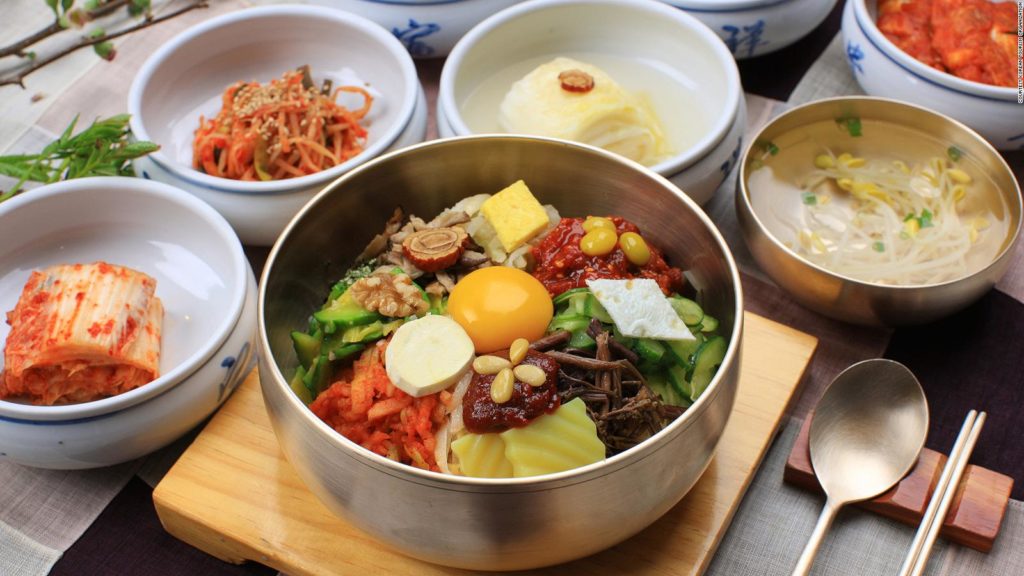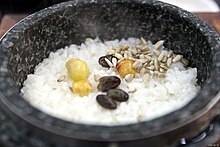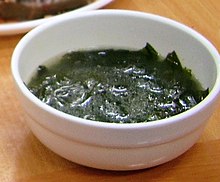Korean cuisine is largely based on rice, vegetables, and (at least in the South) meats. Traditional Korean meals are named for the number of side dishes (반찬; 飯饌; banchan) that accompany steam-cooked short-grain rice. Kimchi is served at nearly every meal. Commonly used ingredients include sesame oil, doenjang (fermented bean paste), soy sauce, salt, garlic, ginger, gochukaru (pepper flakes), gochujang (fermented red chili paste) and napa cabbage.

Ingredients and dishes vary by province. Many regional dishes have become national, and dishes that were once regional have proliferated in different variations across the country. Korean royal court cuisine once brought all of the unique regional specialties together for the royal family. Foods are regulated by Korean cultural etiquette.

Grains

Dolsotbap, cooked rice in a stone pot (dolsot)
Grains have been one of the most important staples of the Korean diet. Early myths of the foundations of various kingdoms in Korea center on grains. One foundation myth relates to Jumong, who received barley seeds from two doves sent by his mother after establishing the kingdom of Goguryeo.[3] Yet another myth speaks of the three founding deities of Jeju Island, who were to be wed to the three princesses of Tamna; the deities brought seeds of five grains which were the first seeds planted, which in turn became the first instance of farming.[4]
Meat

Koreans enjoying grilled meat and alcohol in the 18th centurySee also: List of Korean dishes § Meat-based dishes
In antiquity, most meat in Korea was likely obtained through hunting and fishing. Ancient records indicate rearing of livestock began on a small scale during the Three Kingdoms period. Meat was consumed roasted or in soups or stews during this period. Those who lived closer to the oceans were able to complement their diet with more fish, while those who lived in the interior had a diet containing more meat.[21]
Fish and seafood
See also: List of Korean dishes § Fish-based dishes, and Jeotgal

A bowl of gejang, marinated crabs in soy sauce and plates of various banchan (small side dishes)
Fish and shellfish have been a major part of Korean cuisine because of the oceans bordering the peninsula. Evidence from the 12th century illustrates commoners consumed a diet mostly of fish and shellfish, such as shrimp, clams, oysters, abalone, and loach, while sheep and hogs were reserved for the upper class.[27]
Vegetables

Miyeok guk, a soup made from the sea seaweed, miyeokSee also: List of Korean dishes § Vegetable-based dishes
Korean cuisine uses a wide variety of vegetables, which are often served uncooked, either in salads or pickles, as well as cooked in various stews, stir-fried dishes, and other hot dishes.[33] Commonly used vegetables include Korean radish, napa cabbage, cucumber, potato, sweet potato, spinach, bean sprouts, scallions, garlic, chili peppers, seaweed, zucchini, mushrooms and lotus root. Several types of wild greens, known collectively as chwinamul (such as Aster scaber), are a popular dish, and other wild vegetables such as bracken fern shoots (gosari) or Korean bellflower root (doraji) are also harvested and eaten in season.[34] Medicinal herbs, such as ginseng, lingzhi mushroom, wolfberry, Codonopsis pilosula, and Angelica sinensis, are often used as ingredients in cooking, as in samgyetang.
Medicinal foods
Medicinal food (boyangshik) is a wide variety of specialty foods prepared and eaten for medicinal purposes, especially during the hottest 30-day period in the lunar calendar, called sambok. Hot foods consumed are believed to restore ki, as well as sexual and physical stamina lost in the summer heat.[35][36] Commonly eaten boyangshik include ginseng, chicken, black goat, abalone, eel, carp, beef bone soups, pig kidneys and dog.[37][38]
